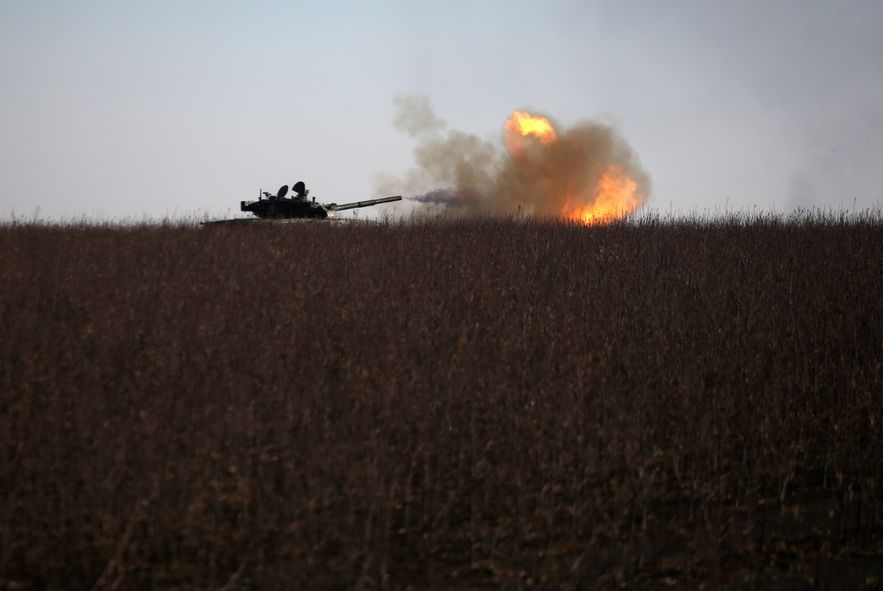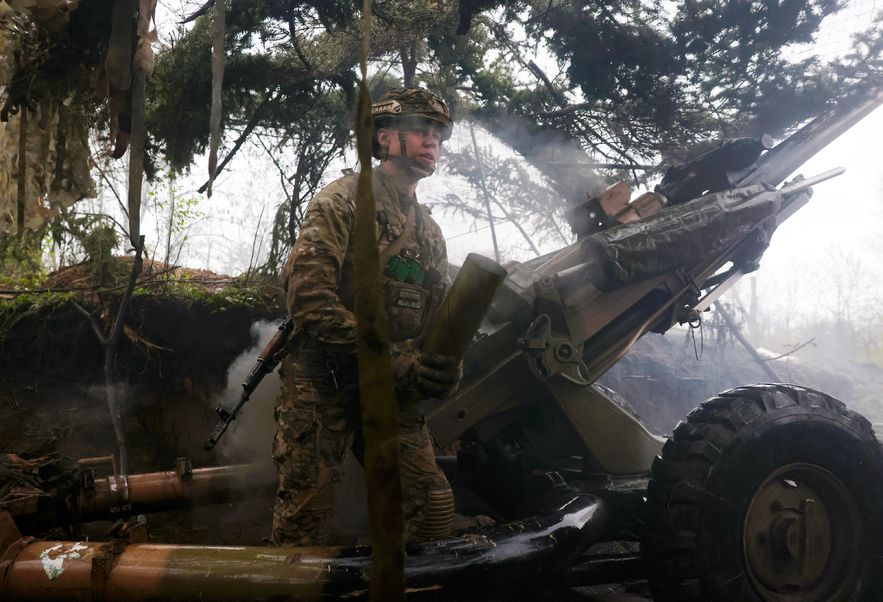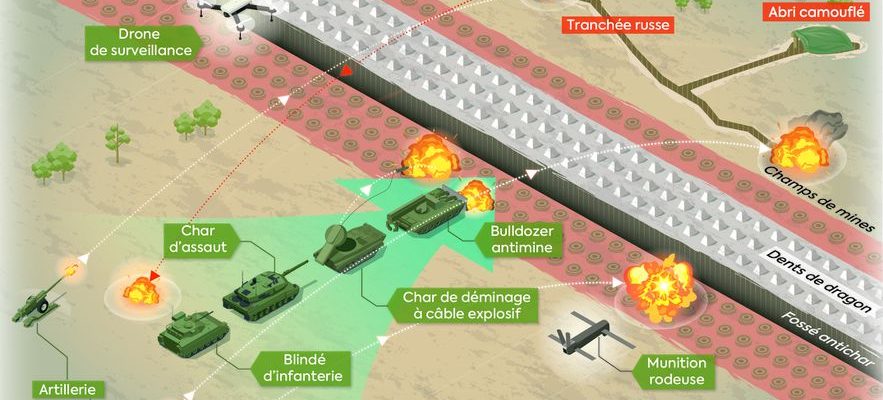The Norwegians had nicknamed “Hitler’s teeth” the concrete blocks sown on their coasts by the Nazi army during the construction of the Atlantic wall from 1942. Those of Vladimir Putin sprang from the ground by the hundreds of thousands , in eastern Ukraine, in recent months along a 950 kilometer front line. This immense jaw, the master of the Kremlin hopes to close it soon on the Ukrainian forces and extinguish the hopes of reconquest of an entire nation.
For several weeks, kyiv has made no secret of its intention to launch a counter-offensive capable of driving out the Russian invader and opening up new military and diplomatic prospects. To achieve this, his soldiers will have to break through a defensive line where their opponents are waiting for them with the firm intention of destroying them. A most perilous operation: “No military enterprise is more difficult to plan, orchestrate and execute”, insists in a note retired Australian General Mick Ryan.
In the zone most suitable for large maneuvers, the plain of Zaporijia, the Russians have set up a sophisticated defense system. They not only installed “dragon’s teeth” – another nickname for these 1 meter high concrete pyramids – often in three rows, to block the progress of armored vehicles. Added to this in parallel is an anti-tank ditch and minefields, which are difficult to detect on images obtained by drones or satellites. Behind these, a few hundred meters away, trenches and shelters provide cover for troops and equipment.
This is just the single line device. North of Melitopol, there would be in all “three layers of defensive zones about 120 kilometers”, consisting of “forward combat positions, then two almost continuous and more elaborate defensive zones, each located 10-20 kilometers away behind that which precedes it,” said the British Ministry of Defence. “Defenses have the potential to be formidable obstacles, he added. But their usefulness depends almost entirely on their support by sufficient artillery and personnel.”
Find weak points
This is the luck of the Ukrainians: the Russian army cannot ensure a reinforced presence on a front longer than the Western front of the First World War. Intelligence must enable the Ukrainian army to detect weak points in these defences. “They will seek to destroy the ammunition depots and the Russian command posts in this area with their precision rocket launchers, explains a military source. They must find a more fragile place by carrying out several attacks to camouflage the area from where part of their main effort.”
map europe ukraine mines
© / Art Press
“The main difficulty will indeed be to hide these preparations from the many enemy sensors: infiltrated agents, listening, drones, satellites, specifies on his blog the historian and former colonel Michel Goya. After more than a year of war, the Ukrainians are now well established in this exercise: movement out of satellite views (whose overflights are announced by the Americans) and at night, radio discipline, camouflage But, as it is practically impossible to hide everything, it will also be necessary to include feints and deceptive movements.” What the military call, in their jargon, “deception operations”.
For that corresponding to the crossing of obstacles, insiders speak of “breaching”. The assailant never puts the tank before the shell: the ground offensive begins once the artillery has pounded the identified obstacles. Then, the breakthrough is ensured by the engineer units, responsible for opening the way for the others. “In a high-intensity war like that in Ukraine, with fixed lines, it is up to the sappers to breach the enemy’s device to give the troops mobility,” explains a former engineering colonel.

A Ukrainian tank fires towards Russian positions near Bakhmout on January 26, 2023.
© / afp.com/Anatolii Stepanov
“During such an offensive, we demine not by hand, but with heavy machinery, he continues. We have to act quickly, there are not 36 solutions.” The mines must first be detonated using the rotating flail of certain vehicles or using explosive cables projected by systems such as the American M58 Miclics or the Russian UR-77s available to Kiev, which then clear a path of nearly a hundred meters long and 6 to 8 meters wide. It is then necessary to pass a bulldozer whose blades plow the ground, push the mines on the sides and can fill the ditches… despite the enemy aftershocks.
A minefield can have devastating effects on an attempted assault. The Russians had the bitter experience of this at Voulhedar, under the eye of drones, at the beginning of February, when a column of armored vehicles found itself blocked at a crossroads, at the mercy of Ukrainian artillerymen. The latter had already wreaked havoc in early May 2022, during a failed attempt to cross a natural obstacle, the Donets River, in northern Donbass, at Bilohorivka. Blocked around the floating bridges posed by its engineering units, an entire Russian battalion had been decimated.
The Ukrainians have been warned: it is only if they avoid these kinds of mistakes and benefit from good cover that they will be able to break through. “Then comes the exploitation phase, explains Yann Boivin, former lieutenant-colonel in the French cavalry and host of the Blablachars blog. Thanks to genius, you have passed four tanks, so you have to put the package in.” These will seek to penetrate into the enemy territory by destroying the armored vehicles and the positions of the enemy. In this game, the German Leopard 2s and the British Challenger 2s recently delivered to kyiv are a major asset: they shoot further and with more precision than the Soviet models.
Harness the Breakthrough
In the wake of the tanks, the infantry must secure this progression. “A maneuver is organized, a group will fire on an enemy position to fix it, while a second will take cover against potential enemy reinforcements, while a third group will go up to the assault, details a military source familiar with this type of combat. All this takes time, because it is necessary to treat the prisoners, the dead, the wounded, to recover abandoned information, like maps. It is adrenaline dense, tiring nervously and physically…”
Then, as soon as possible, we must push further into enemy territory. “A real breakthrough is when, after passing the first defense zones and protecting your flanks, you find yourself in an area where there are no more mines, where you can move as fast as the adversary, explains Yohann Michel, researcher on defense issues at the International Institute for Strategic Studies (IISS). The breakthrough must make it possible to find room for maneuver to regain the initiative.

Ukrainian soldiers fire at Russian positions on the front line in the Lugansk region on April 20, 2023 in Ukraine.
© / afp.com/Anatolii Stepanov
To achieve this precise choreography, thousands of Ukrainians, from soldiers to generals, have been trained for months by their Western supporters in combined arms combat, in military camps in Germany, Poland and the United Kingdom. Under the watchful eye of NATO instructors, they learned to coordinate their artillery, cavalry and infantry units and those to whom the crucial task of logistics will fall. In addition, there are units responsible for monitoring the theater of operations or the use of electronic jamming systems.
Undoubtedly, the Kremlin forces will try to thwart the Ukrainian attempts by relying, as they have always done since the start of the invasion, on the firepower of their artillery. The speed of reaction will be one of the keys to the battle: “Russians capable of carrying out a more effective mobile defense would represent a very different enemy for the Ukrainians than in the last fourteen months”, underlined the Australian strategist Mick Ryan , adding that such ventures are “inevitably bloody”.
“We are going to death, because the result is never sure, abounds the former colonel of engineers. The Ukrainian strategists have shown a lot of ingenuity and can still surprise their adversary, but, faced with the preparations of the Russians, I am pessimist.” A lack of breakthrough or a limited progression of the Ukrainians could put a stop to the reconquest of their lost territories, the time to be reinforced in men and equipment. The forehead would be frozen. As Western military stocks dwindle, such a scenario could push some partners to encourage Ukraine to open negotiations with Moscow.
Conversely, if the Ukrainians manage to break through and exploit their advantage in depth, the defenders, caught in the rear, could abandon whole swaths of territory, as was the case east of Kharkiv at the beginning of September. The ideal scenario would see the Ukrainian army join the Sea of Azov and cut the Russian front in two. Such an uppercut to the jaw deployed by Putin would not only blow his dragon teeth. It would open the field of possibilities, maintaining the hope of a complete military defeat of the Russian army.
